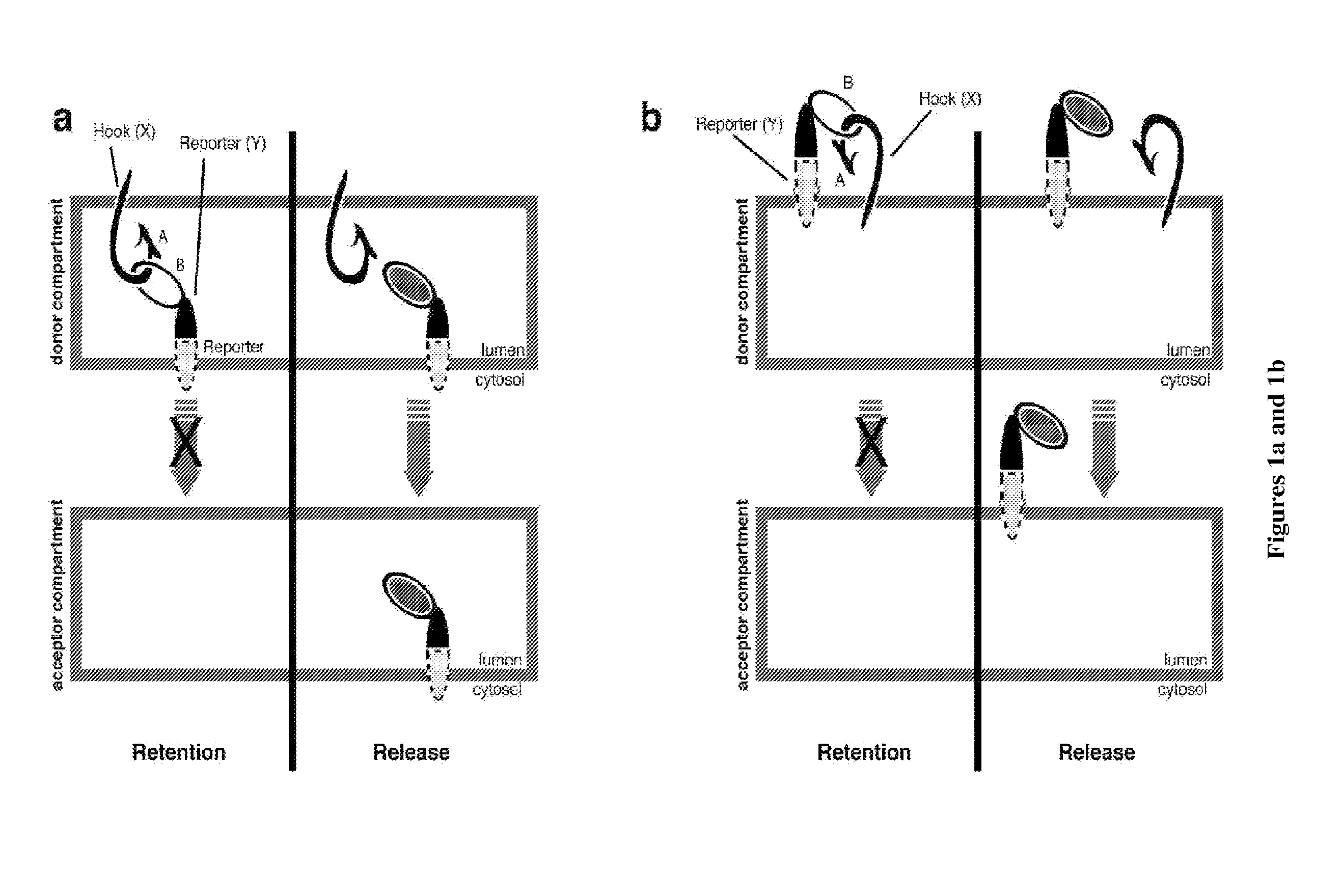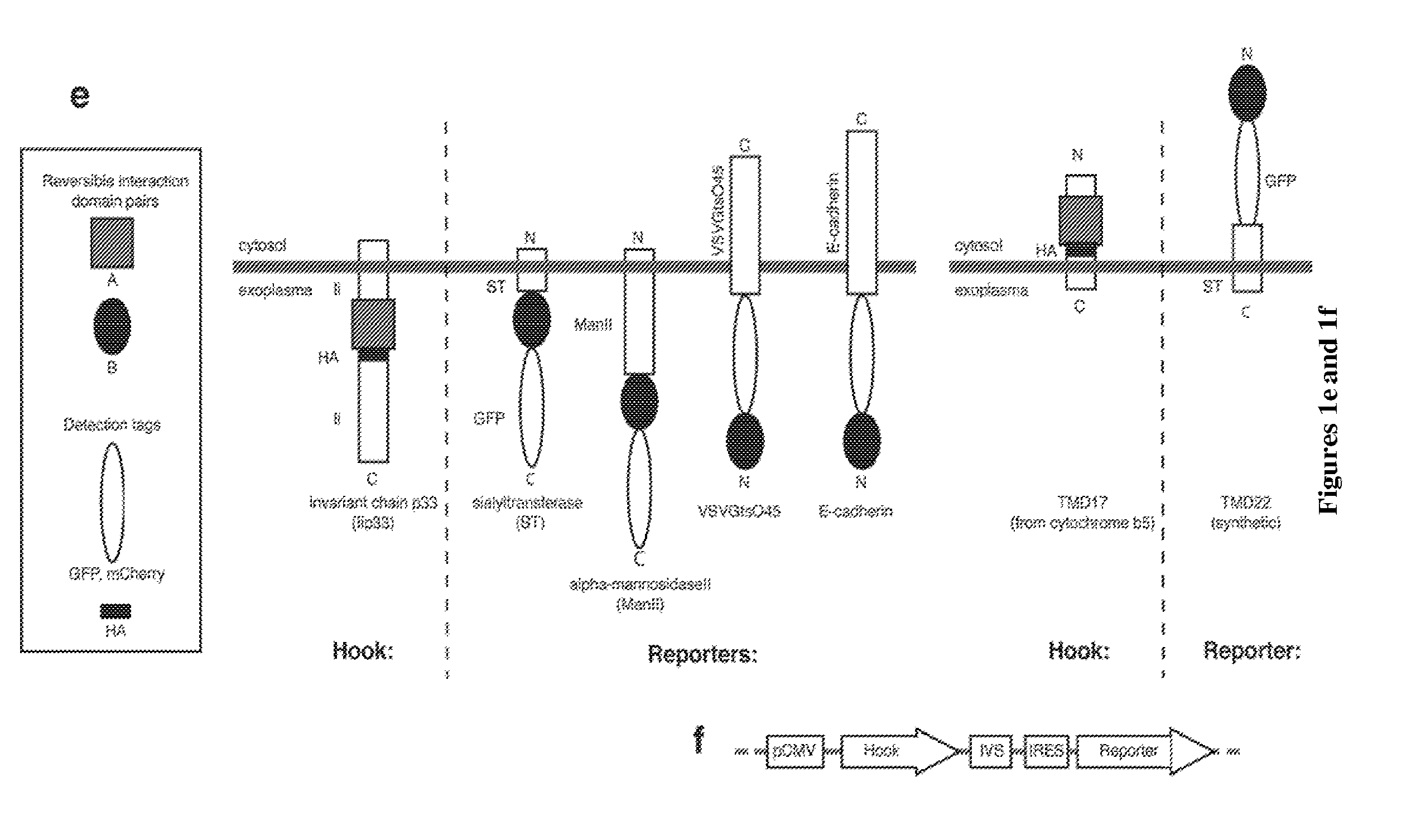Methods and kits for regulating intracellular trafficking of a target protein
a technology for targeting proteins and kits, applied in the direction of peptides, fusion with spectroscopic/fluorescent detection, fungi, etc., can solve the problems of causing irreparable damage, suffering from various drawbacks, and affecting the efficiency of the powerful system
- Summary
- Abstract
- Description
- Claims
- Application Information
AI Technical Summary
Benefits of technology
Problems solved by technology
Method used
Image
Examples
example 1
Molecule-Dependant Interaction Between FRAP and FKBP12 and Trafficking of a Golgi Enzyme, Sialyl-Transferase (FIG. 2)
Summary
Hook Construct: Ii-FRAP-HA
Reporter Construct: Sialyl Transferase-FKBP12-GFP
[0179]In this example, the Hook is based on a variant of the Invariant Chain that cannot move out from the ER. It is fused to the rapamycin-binding protein FRAP to form a first fusion protein and to a HA tag for immunostaining. The reporter is the targeting sequence of a Golgi enzyme sequence (sialyl transferase) fused to the rapamycin- and FK506-binding protein FKBP12 to form the second fusion protein. To follow its trafficking, the reporter has also been fused to a fluorescent GFP protein. The donor compartment is the ER and the target compartment is the Golgi apparatus. Both reporter and hook are expressed under the control of a single promoter.
[0180]Retention of the reporter in the ER occurred in the presence of rapamycin. Upon wash-out of rapamycin, and in the presence of FK506 to c...
example 2
Interaction by Default Between Streptavidin / SBP Tag and Trafficking of a Golgi Enzyme, Sialyl-Transferase (FIGS. 3 and 4)
Summary
Hook: Ii-FRAP
Reporter: Sialyl Transferase-FKBP12-GFP
[0185]In this example, the Hook is based on a variant of the Invariant Chain that cannot move out from the ER. It is fused to the core streptavidin to form a first fusion protein and to a HA tag for immunostaining. The reporter is the targeting sequence of a Golgi enzyme sequence (sialyl transferase) fused to the streptavidin-interacting SBP peptide to form the second fusion protein. To follow its trafficking, the reporter has also been fused to a fluorescent GFP protein. The donor compartment is the ER and the target compartment is the Golgi apparatus. Both reporter and hook are expressed under the control of a single promoter.
[0186]Retention of the reporter in the ER occurred by default due to the interaction between SBP and core streptavidin. Upon addition of biotin the reporter was released and traffic...
example 3
Interaction by Default Between Streptavidin / SBP Tag and Trafficking of a Golgi Enzyme Mannosidase II (FIG. 5)
[0192]As in Example 2 but using Mannosidase II targeting domain as a reporter molecule. This example provides another sort of Golgi enzyme to be analyzed. By fusing it to a red fluorescent protein, it was possible to observe two Golgi enzymes (or a Golgi enzyme and another cargo) at the same time and between the same donor and acceptor compartments.
PUM
| Property | Measurement | Unit |
|---|---|---|
| Electrical resistance | aaaaa | aaaaa |
Abstract
Description
Claims
Application Information
 Login to View More
Login to View More - R&D
- Intellectual Property
- Life Sciences
- Materials
- Tech Scout
- Unparalleled Data Quality
- Higher Quality Content
- 60% Fewer Hallucinations
Browse by: Latest US Patents, China's latest patents, Technical Efficacy Thesaurus, Application Domain, Technology Topic, Popular Technical Reports.
© 2025 PatSnap. All rights reserved.Legal|Privacy policy|Modern Slavery Act Transparency Statement|Sitemap|About US| Contact US: help@patsnap.com



